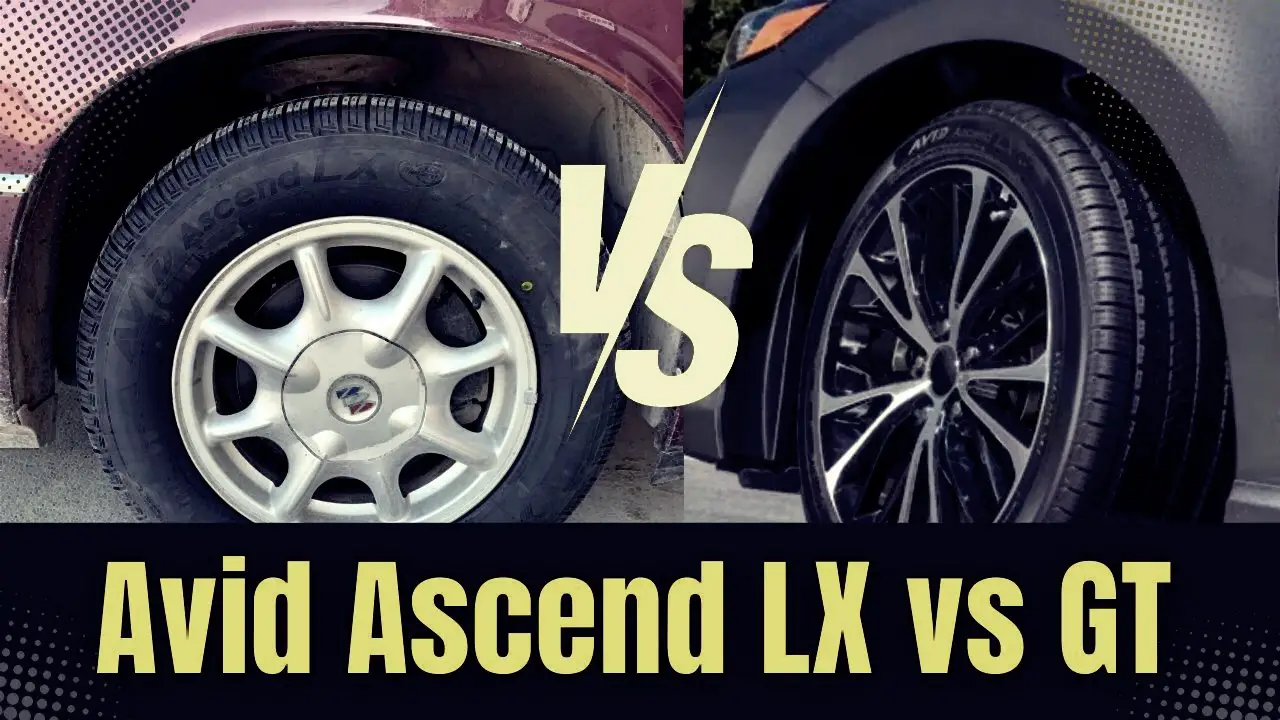Yokohama Avid Ascend LX vs GT

Two standout choices from Yokohama’s Avid Ascend lineup—the LX and the GT—promise reliable all-season performance, but they cater to slightly different needs.
Whether you’re a daily commuter racking up highway miles or someone navigating wet urban streets, understanding how these tires stack up could save you time, money, and frustration.
Let’s dive into a detailed comparison of the Yokohama Avid Ascend LX and GT, exploring their strengths and trade-offs to help you pick the right set for your ride.
Avid Ascend LX vs GT
This table captures the essence of each tire, making it easy to compare at a glance.
| Feature | Yokohama Avid Ascend LX | Yokohama Avid Ascend GT |
|---|---|---|
| Mileage Warranty | Offers 85,000 miles, perfect for long highway hauls. | Gives 65,000 miles, or 32,500 for staggered rears, solid for mixed use. |
| Price | Ranges $100-$200, slightly pricier for performance. | Falls $100-$200, often cheaper for balanced comfort. |
| Tire Type | All-season touring, performance-focused with H/V ratings. | Grand touring all-season, built for luxury and ease. |
| Rim Range | Covers 15 to 18 inches, suits standard cars and crossovers. | Spans 15 to 20 inches, fits sporty sedans and bigger wheels. |
| Tread Pattern | Staggered design cuts noise, boosts wet grip. | Asymmetric with 3D sipes, excels in snow and rain. |
| Off-Road | Sticks to pavement, not built for trails. | Light gravel possible, but thrives on roads. |
| On-Road | Rules dry roads with top grip, decent in wet. | Shines in wet and light snow, balanced all-season. |
| Expert Opinion | Praised for mileage and dry performance by pros. | Loved for wet traction and comfort, per experts. |
| Our Observation | Best for highway longevity, dry climates, great value. | Ideal for mixed weather, urban drives, versatile sizes. |
Mileage Warranty
Tread life often tops the list of concerns for tire shoppers, and here the LX takes a clear lead. Yokohama backs it with an 85,000-mile limited treadwear warranty across all 39 of its T-, H-, and V-rated sizes, signaling confidence in its durability.
This makes it a compelling choice if you’re logging serious miles on highways or planning to keep your vehicle for the long haul.
Real-world feedback, like a glowing review on BobIsTheOilGuy, praises the LX for holding up well over time, though warranties don’t always guarantee identical wear for every driver—road conditions and habits play a role.
The GT, by contrast, offers a 65,000-mile warranty for non-staggered fitments and front-position tires in staggered setups, dropping to 32,500 miles for rear tires in staggered configurations.
This split reflects its design for luxury sports sedans and coupes, where staggered fitments (different sizes front and rear) are common.
While 65,000 miles is respectable, it falls short of the LX’s promise, suggesting the GT might wear out sooner, especially under aggressive driving or heavy loads. For budget-conscious drivers eyeing long-term value, the LX’s edge in mileage stands out.
Tire Price
Tire pricing can fluctuate based on size, retailer, and regional availability, but both the LX and GT generally fall between $100 and $200 per tire. The LX often commands a slight premium, likely due to its performance focus and higher mileage warranty.
Checking Discount Tire or Tire Rack reveals that a 205/55R16 LX might hover around $130-$150, while the GT in the same size could dip closer to $120-$140.
These are ballpark figures—exact costs depend on your vehicle and local deals—but the difference is rarely drastic enough to sway a decision alone. Both tires strike a balance between affordability and quality, making them accessible for most drivers.
Tire Type
Both tires belong to the all-season touring family, but their flavors differ. The LX is a performance-oriented touring tire, with H- and V-speed ratings that hint at its capability for spirited driving and highway stability.
It’s tailored for crossovers and sedans where dry grip and a quiet ride matter most. The GT, launched as a successor to the Avid ENVigor, leans into the grand touring category, targeting luxury sports sedans and coupes.
Its design prioritizes comfort alongside all-season versatility, making it a jack-of-all-trades for drivers who value refinement over raw performance.
Your choice here might hinge on whether you lean toward the LX’s performance edge or the GT’s cushioned balance.
Rim Diameter Range
Fitment flexibility matters, and the GT has a broader reach. It’s available for rim diameters spanning 15 to 20 inches, accommodating everything from compact cars to larger luxury vehicles.
The LX, however, sticks to a 15-to-18-inch range, starting at 185/60R15 and topping out at 235/45R18.
This makes the LX a go-to for standard passenger cars and crossovers, while the GT’s wider scope suits those with bigger wheels or sportier rides. If your vehicle falls outside the LX’s range, the GT becomes your default pick—simple as that.
Tread Pattern
A tire’s tread tells a story of its priorities, and both the LX and GT feature thoughtful designs. The LX sports a staggered, offset pattern to minimize road noise, paired with shoulder sipes and notches for light snow traction.
Wide circumferential and lateral grooves enhance wet braking, making it a solid all-season contender. The GT counters with an asymmetric tread, packed with 3D sipes and a notched block design for snowy grip, plus deep grooves to channel water away.
While the LX excels at keeping things quiet and steady on dry pavement, the GT’s tread suggests a slight edge in wet and wintry conditions. Neither is a mud-slinging off-roader, but their patterns reflect their on-road missions.
Off-Road Performance
Let’s be clear: neither tire is built for off-road adventures. As all-season touring options, they’re happiest on asphalt.
That said, the GT’s notched blocks and sipes might offer a tad more bite on gravel or light trails, thanks to its snow-focused design.
The LX, with its performance bent, doesn’t pretend to stray far from paved roads. If you’re dreaming of rugged terrain, look elsewhere—perhaps Yokohama’s Geolandar line—but for occasional dirt paths, the GT might just edge out the LX by a hair.
On-Road Performance
On pavement, these tires shine in different lights. The LX earns praise for its dry performance, with reviews like those from DrivingPress highlighting its stability and grip on sun-baked roads.
It’s a strong pick for warm climates or long, dry commutes, though it holds its own in moderate rain. Wet and snowy traction are decent, but heavy snow or ice? You’ll want dedicated winter tires instead.
The GT, meanwhile, flexes its muscles in wet conditions, with a silica-rich compound and aggressive handling earning nods from users on Reddit’s r/tires for rain-soaked drives.
It also manages light snow better than the LX, though it, too, falters in extreme winter weather. For dry dominance, the LX leads; for wet versatility, the GT pulls ahead.
Expert Opinion
Industry voices offer valuable perspective. Experts at Tire Business and Modern Tire Dealer laud the LX for its mileage and dry-road prowess, with its 85,000-mile warranty often cited as a standout feature.
The GT gets props for its balanced approach, with Modern Tire Dealer noting its 65,000-mile warranty and wet/snow traction as strong selling points for grand touring fans.
Some pros, however, caution that warranties are partly marketing—real-world wear varies with driving style and maintenance. Both tires earn high marks, but the LX tends to win over mileage seekers, while the GT appeals to those prioritizing comfort and all-weather grip.
Our Observation
So, which tire should you roll with? It boils down to your driving life. If you’re a highway warrior or live in a dry climate, the Avid Ascend LX is your match. Its 85,000-mile warranty, dry performance, and quiet ride make it a longevity champ—perfect for racking up miles without worry.
But if you face mixed conditions—rainy streets, occasional snow, or urban stop-and-go—the GT’s versatility shines. Its wet traction and broader size range cater to drivers who need adaptability, even if it trades some tread life for that balance.
Neither tire conquers extreme winters or off-road trails, so factor in your climate and roads. For us, the LX edges out slightly for value, but the GT’s all-around appeal keeps it in the race.

Meet Caitlin McCormack, a Tire Size Expert and Blogger Passionate About Everything Related to Tires. With Years of Experience in the Tire Industry, Caitlin Has Become an Expert in Tire Sizes and Their Impact on Vehicle Performance.
